The document discusses materials engineering, focusing on the relationships between the structure and properties of materials, including metals, ceramics, polymers, and composites. It explores the classification and characteristics of these materials, their applications in high technology, and deformation mechanisms, detailing elastic and plastic behaviors. Additionally, it covers materials selection processes and the importance of advanced materials in modern applications.










![11
Slip systems:
Dislocations move more easily on specific planes and in specific directions.
Ordinarily, there is a preferred plane (slip plane), and specific directions (slip direction)
along which dislocations move. The combination of slip plane and slip direction is called
the slip system.
The slip system depends on the crystal structure of the metal.
The slip plane is the plane that has the most dense atomic packing (the greatest planar
density). The slip direction is most closely packed with atoms (highest linear density)
Crystal Slip plane(s)
Slip direction
(b vector)
Number of
slip systems
FCC {111} ½<110> 12
HCP (0001) <1120> 3
BCC
{110}, {112},
{123}
½[111] 48
Stress to move a dislocation: Peierls – Nabarro (PN) stress:
At the fundamental level the motion of a dislocation involves the rearrangement of bonds
which requires application of shear stress on the slip plane.
Consider plastic deformation is the transition between unslipped to slipped state. As this
process is opposed by an energy barrier ΔE, the materials cannot make the transition
simultaneously.
To minimize the energetic of the process the slipped material will grow at the expenses of
the unslipped region by the advance of an interfacial region (width of the dislocation w).](https://image.slidesharecdn.com/materialsengineering-160429091132/85/Materials-Engineering-Lecture-Notes-11-320.jpg)

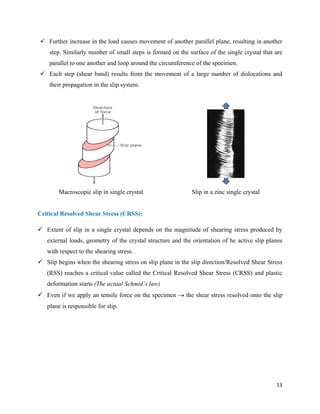
![14
Area
Force
Stress
CosA
CosF
/
CosCosRSS
CosCos Schmid factor
τ RSS is maximum (F/2A) when ϕ = λ=45o
If the tension axis is normal to slip plane i.e. λ=90o
or if it is parallel to the slip plane i.e.
ϕ = 90o
then τ RSS = 0 and slip will not occur as per Schmid’s law.
Schmid’s law: Slip is initiated when
CRSS is a material parameter, which is determined from experiments
Yield strength of a single crystal
Solved Example: Determine the tensile stress that is applied along the ]011[
axis of a silver
crystal to cause slip on the ]110)[111(
system. The critical resolved shear stress is 6 MPa.
Solution: ]Determine the angle ϕ between the tensile axis and normal to using the
following equation.
RSS CRSS
CRSS
y
Cos Cos
]011[
)111(
](https://image.slidesharecdn.com/materialsengineering-160429091132/85/Materials-Engineering-Lecture-Notes-14-320.jpg)
![15
))((
θcos 2
2
2
2
2
2
2
1
2
1
2
1
212121
wvuwvu
wwvvuu
6
2
32
1
])1()1()1][()0()1()1[(
)1)(0()1)(1()1)(1(
cos 222222
Determine the angle λ between tensile axis ]011[
and slip direction ]110[
2
1
22
1
])1()1()0][()0()1()1[(
)1)(0()1)(1()0)(1(
cos 222222
Then calculate the Tensile Stress using the expression:
Mpa
MPa
A
P
7.1466
2
1
6
2
6
coscos
RSS
Solved Example: Consider a single crystal of BCC iron oriented such that a tensile stress is
applied along a [010] direction.
(a) Compute the resolved shear stress along a (110) plane and in a [111] direction when a tensile
stress of 52 MPa (7500 psi) is applied
(b) If slip occurs on a (110) plane and in a direction, and the critical resolved shear stress is
30 MPa (4350 psi), calculate the magnitude of the applied tensile stress necessary to initiate
yielding.
Solution:
Determine the value of the angle between the normal to the (110) slip plane (i.e., the [110]
direction) and the [010] direction using [u1v1w1] = [110], [u2v2w2] = [010] and the following
equation.
))((
cos 2
2
2
2
2
2
2
1
2
1
2
1
2121211
wvuwvu
wwvvuu
]111[
](https://image.slidesharecdn.com/materialsengineering-160429091132/85/Materials-Engineering-Lecture-Notes-15-320.jpg)
![16
])0()1()0][()0()1()1[(
)0)(0()1)(1()0)(1(
cos 222222
1
Similarly determine the value of λ, the angle between and [010] directions as follows:
Then calculate the value of τ RSS using the following expression:
τ RSS = σ cosϕ cosλ
=(152 Mpa)(cos 45)(cos 54.7)
= 21.3 Mpa
= 13060 psi
Yield Strength σY:
Mpa
MPa
y 4.73
)7.54)(cos45(cos
30
Plastic deformation by Twin:
Twins are generally of two types: Mechanical Twins and Annealing twins
Mechanical twins are generally seen in bcc or hcp metals and produced under conditions of
rapid rate of loading and decreased temperature.
Annealing twins are produced as the result of annealing. These twins are generally seen in
fcc metals.
Annealing twins are usually broader and with straighter sides than mechanical twins.
o
45)
2
1
(cos 1
]111[
o
7.54)
3
1
(cos
])0()1()0][()1()1()1[(
)0)(1()1)(1()0)(1(
cos 11
222222
](https://image.slidesharecdn.com/materialsengineering-160429091132/85/Materials-Engineering-Lecture-Notes-16-320.jpg)
![17
(a) Mechanical Twins (Neumann bands in iron), (b) Mechanical Twins in zinc produced by
polishing (c) Annealing Twins in gold-silver alloy
Twinning generally occurs when the slip systems are restricted or when the slip systems are
restricted or when something increases the critical resolved shear stress so that the twinning
stress is lower than the stress for slip.
So, twinning generally occurs at low temperatures or high strain rates in bcc or fcc metals or
in hcp metals.
Twinning occurs on specific twinning planes and twinning directions.
Crystal
Structure
Typical
Examples
Twin Plane Twin Direction
BCC α-Fe, Ta (112) [111]
HCP
Zn, Cd,
Mg, Ti
FCC Ag, Au, Cu (111) [112]
(Twin planes and Twin directions)
)2110(
]0111[
](https://image.slidesharecdn.com/materialsengineering-160429091132/85/Materials-Engineering-Lecture-Notes-17-320.jpg)
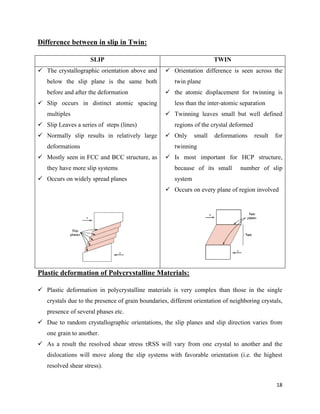


















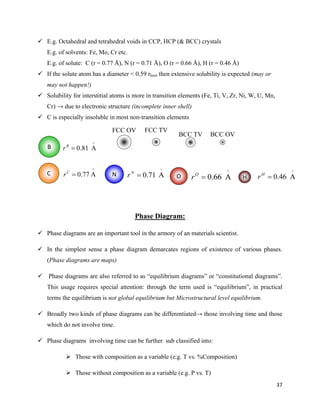




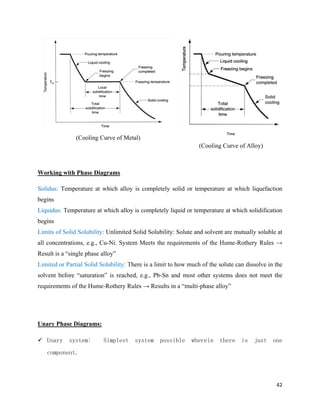



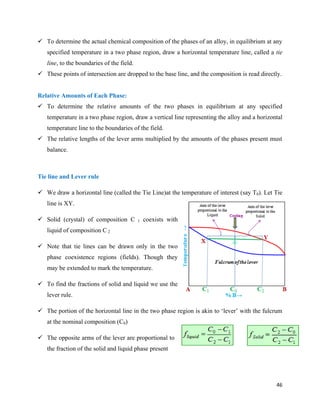











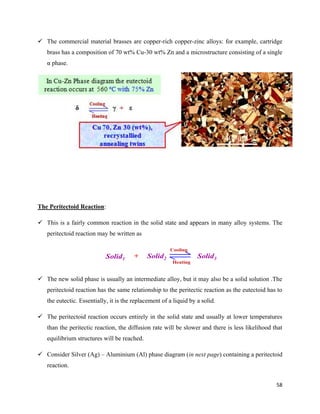

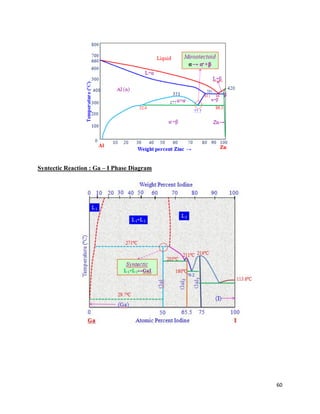



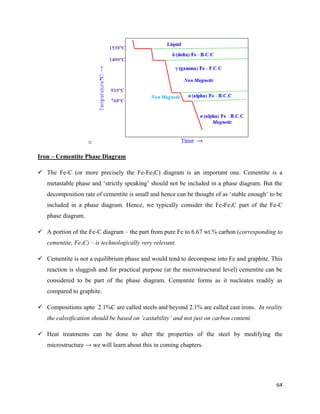




![69
Phase changes that occur upon passing from the γ
region into the α+ Fe3C phase field.
Consider, for example, an alloy of eutectoid
composition (0.8%C) as it is cooled from a temperature
within the γ phase region, say 800ºC – that is, beginning
at point ‘a’ in figure and moving down vertical xx’.
Initially the alloy is composed entirely of the austenite
phase having composition 0.8 wt.% C and then
transformed to α+ Fe3C [pearlite]
The microstructure for this eutectoid steel that is slowly
cooled through eutectoid temperature consists of
alternating layers or lamellae of the two phases α and Fe3C.
The pearlite exists as grains, often termed “colonies”; within each colony the layers are
oriented in essentially the same direction, which varies from one colony to other.
The thick light layers are the ferrite phase, and the cementite phase appears as thin lamellae
most of which appear dark.](https://image.slidesharecdn.com/materialsengineering-160429091132/85/Materials-Engineering-Lecture-Notes-69-320.jpg)



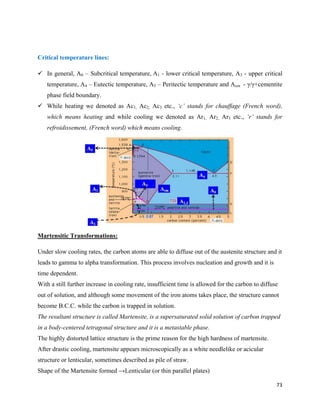
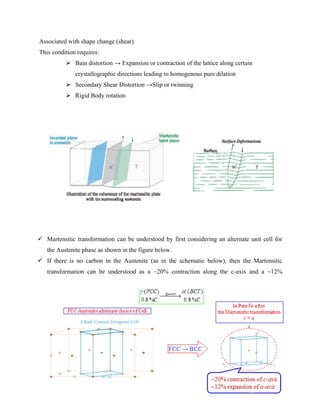















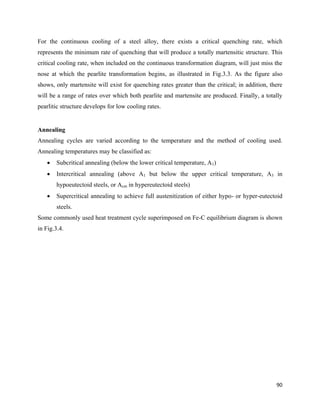
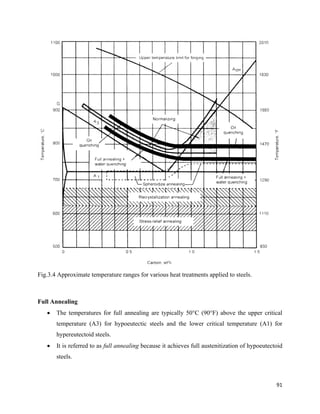


















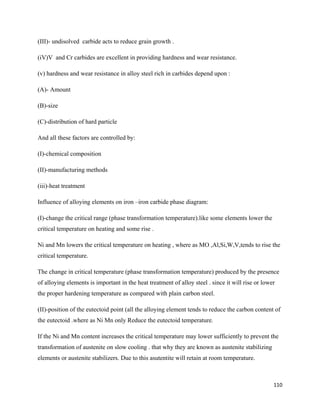

![112
(V)- Ni is best in providing toughness at lower temperature, but have a mild effect on
hardenibility.
(vi)-application of different NI steels are
(A)-23xx series steel which contains 3.5 per Ni and low carbon are used for carburising of srives
gears ,connecting rod bolts studs, and kingpins.
(b)-25xx series that is 5 per Ni which provide high toughness used for heavy duty applications
such asbus and truck gears, cams,and crankshaft.
Chromium steel(5XXXseries):
(i)-cheaper alloying element than Ni Cr mainly form simple(Cr7C3,Cr4C) and complex carbides
[(Fe3Cr)3C] these carbides provides high hardness and wear resistance.
(ii)-solubilty of Cr in gama irin is 13 per and unlimites solubility in alpha ferrite.
(iii)-at low carbon content Cr main remain in solution form in ferrite which leads to high strength
and toughness of ferrite.
(iv)-If Cr content is present in excess of 5 per the corrosion resistance and high temperature
properties of the steel are greatly improved.
(v)-the plain Cr steel of 15xx series contains 0.15 and 0.64 per carbon and 0.70 and 1.15 per Cr
the low carbon alloy steels in this series are usually carbiurised. The presence of Cr increases the
wear resistance of the case ,but the toughness of the core is not so high as Ni steels. With
medium carbon these steels are oilhardened and are used for springs, engine bolt,studs,axels,
Steel with high carbon (1 per c)and high cr 1.5 per is characterise by high wear resistance and
hardness these are used in ball or roll bearings and for crushing machines.
Steel with 1 per carbon and 2-4 per Cr used for making parment magnets since it has excellent
magnetic properties.
Nickel Chromium steel 3XXXseries:
(I)-in this steel alloying element imparts some of the characteristic properties of each one.](https://image.slidesharecdn.com/materialsengineering-160429091132/85/Materials-Engineering-Lecture-Notes-112-320.jpg)






![119
degree F. To cause a precipitation effect. The lower temperature results in highest strength
and hardness.
5- The 17-4 PH alloy should not be put into service in any application in solution treated
condition because its ductility can be relatively low and its resistance to stress corrosion
cracking is poor.
6- Ageing in these steels not only improves strength and ductility it also improve toughness and
resistance to stress corrosion.
7- The 17-7PH and PH 15-7Mo alloys are solution annealed at 1950 degree F followed by air
cooling. This treatment produces a structure of austenite with about 5 to 20 per delta ferrite .
In this condition the alloy is soft and can be easily formed.
Tool steels :
1-any steels used as an tool is come under class of tool steel.
2-But the term is restricted to high quality special steels used for cutting and forming .
3-tool steels are classified on the basis of three things :
(A)- Quenching medium used[water hardened , oil hardened , airhardened]
(B)-alloy content (composition)[carbon tool steel,low alloy tool steel, medium alloy tool steel]
(C)-application of tool steels[hot work steel, shock resistance steels, high speed steels,cold work
steel.]
Selection of tool steels:
1- Correlating the metallurgical characteristic of tool steel with the requirement of the tool in
operation.
2- Expected productivity, easy of fabrication, and cost, and the cost per unit part made by the
tool.
Tools may be used for cutting operation, shearing,forming,drawing, extrusion , rolling and
battering.
Cutting tools must have (high hardness, wear resistance and good heat resistance)
Shearing tools must have (fair toughness and wear resistance)
Forming tools must have (high toughness and strength and must have high red hardness that is
resistance to heat softening).](https://image.slidesharecdn.com/materialsengineering-160429091132/85/Materials-Engineering-Lecture-Notes-119-320.jpg)


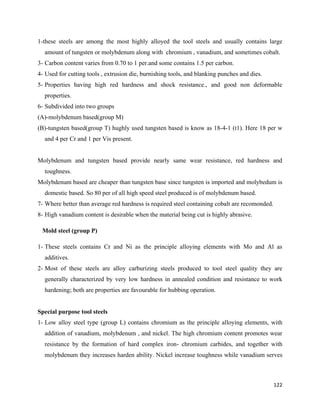



![126
some organic
solvents
Acrylics [poly(methyl
methacrylate)]
Outstanding light
transmission
and resistance
to weathering;
only fair
mechanical
properties
Lenses,
transparent
aircraft
enclosures,
drafting
equipment,
outdoor signs
Fluorocarbons (PTFE or TFE) Chemically inert
in almost all
environments,
excellent
electrical
properties; low
coefficient of
friction; may
be used to
relatively weak
and poor cold-
flow properties
Anticorrosive
seals, chemical
pipes and
valves,
bearings,
antiadhesive
coatings,
hightemperatur
e electronic
parts
Polyamides (nylons) Good mechanical
strength,
abrasion
resistance, and
toughness; low
coefficient of
friction;
absorbs water
and some other
liquids
Bearings, gears,
cams, bushings,
handles, and
jacketing for
wires and
cables](https://image.slidesharecdn.com/materialsengineering-160429091132/85/Materials-Engineering-Lecture-Notes-126-320.jpg)








